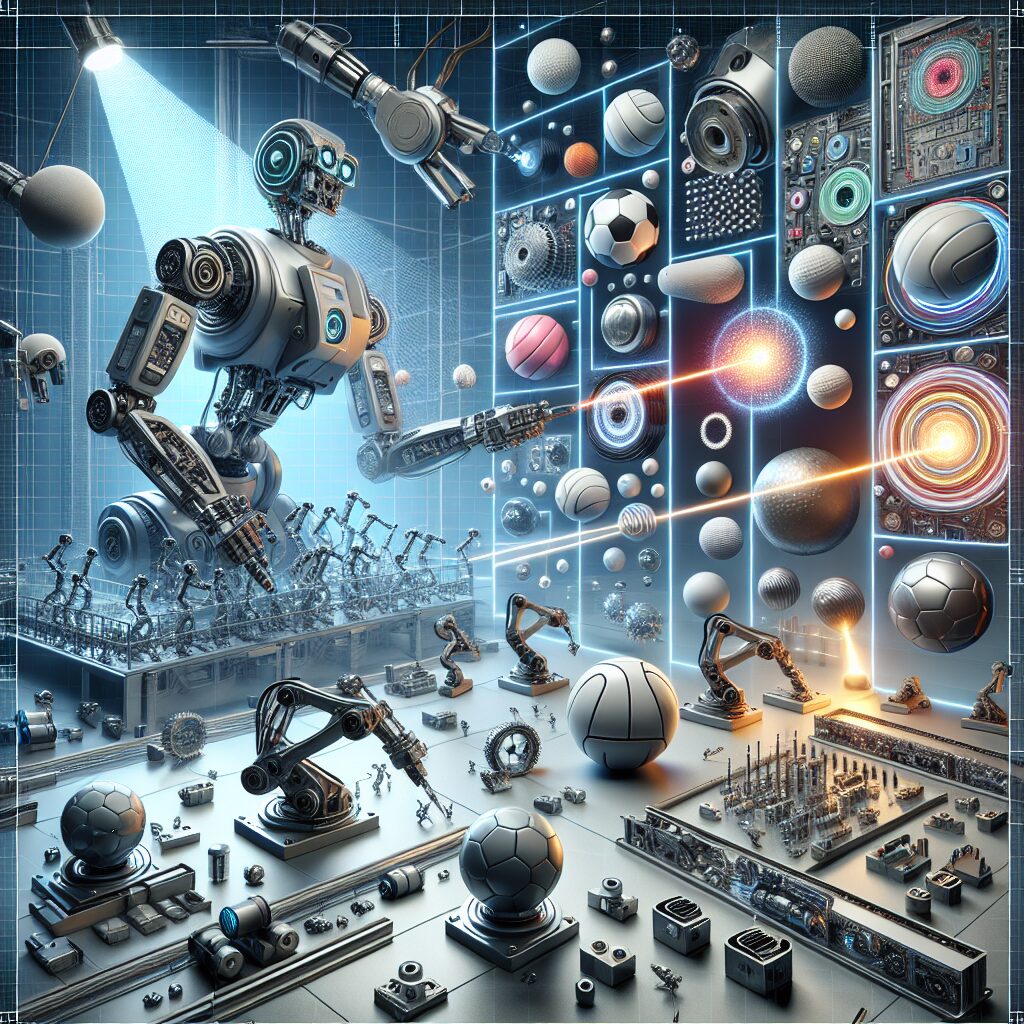Robots in Action: Revolutionizing Ball Manufacturing
Robots have become an indispensable part of various industries, and the world of ball manufacturing is no exception. With their unparalleled precision, efficiency, and adaptability, robots have revolutionized the manufacturing process, making it faster and more streamlined than ever before. These mechanical wonders have the ability to produce high-quality balls with incredible accuracy, ensuring consistent shape, weight, and overall performance.
One of the most remarkable aspects of robots in ball manufacturing is their ability to adapt to different materials and ball types. Whether it’s soccer balls, basketballs, or even ping pong balls, robots can seamlessly switch between different production requirements, making the manufacturing process much more versatile and efficient. Not only does this save time and resources, but it also allows manufacturers to cater to a wide range of customer demands.
Key Takeaways
Now that we have explored the concept of robots in action within the context of ball manufacturing, it’s important to dive deeper into the specific impacts and features of these robotic systems. In the upcoming sections, we will discuss how robots have significantly improved production speed and consistency, leading to higher output and reduced waste. Additionally, we will explore the advancements in robotic technologies that have enabled them to handle various ball materials and types with remarkable precision. So, join us as we unravel the fascinating world of robots revolutionizing ball manufacturing!
Key Takeaways
1. Robotic technology is revolutionizing the ball manufacturing industry by improving efficiency and accuracy in various processes, such as cutting, stitching, and coating.
2. Automated robots are enhancing quality control in ball production, ensuring consistent standards and reducing defects, which ultimately leads to better performance and customer satisfaction.
3. The use of robots in ball manufacturing is not limited to large companies. Small and medium-sized enterprises are also benefiting from this technology, as it provides cost-effective solutions and streamlines operations.
4. Collaborative robots, or cobots, are becoming increasingly popular in ball manufacturing as they can work alongside human operators, increasing productivity and flexibility in the production line.
5. The integration of artificial intelligence and machine learning in robotic systems is further advancing the efficiency and adaptability of ball manufacturing processes. This enables robots to learn and improve autonomously, leading to enhanced overall production output.
Overview of Robots in Action: Revolutionizing Ball Manufacturing
In recent years, the advancement of robotic technology has transformed various industries, and ball manufacturing is no exception. Robots in action have revolutionized the way balls are produced, improving precision, efficiency, and quality. Through this article, we will delve into the various aspects of how robots are transforming ball manufacturing.
Enhanced Precision and Consistency
One of the remarkable benefits of using robots in ball manufacturing is their ability to provide enhanced precision and consistency. Robots can execute repetitive tasks with utmost accuracy, ensuring that each ball meets the strict quality standards. Their precise movements and measurements minimize human errors, resulting in more consistent and precisely crafted balls.
Efficiency and Speed
Robots have dramatically increased the efficiency and speed of ball manufacturing processes. With their advanced programming and capabilities, they can perform tasks at a much faster pace than humans. Robots can handle multiple operations simultaneously, such as molding, painting, and polishing, reducing the production time significantly. This increased efficiency translates into greater productivity and improved delivery times.
Customization and Adaptability
Robotic technology has opened up new possibilities for customization in ball manufacturing. Robots can be programmed to produce balls of various sizes, shapes, and materials, allowing manufacturers to cater to diverse customer demands. Additionally, robots can easily adapt to changes in production requirements, making it easier to introduce new ball designs and keep up with market trends.
Quality Control and Inspection
Ensuring high-quality balls is crucial in the manufacturing process. Robots play a vital role in quality control and inspection, as they are equipped with advanced sensors and cameras. These sensors can detect even the slightest imperfections or defects in balls, allowing for immediate corrective action. By minimizing quality issues, robots help maintain consistency in the final products, increasing customer satisfaction.
Reduced Labor Costs and Safety
Implementing robots in ball manufacturing can significantly reduce labor costs for manufacturers. Robots can handle repetitive tasks, eliminating the need for a large workforce and reducing labor expenses. Moreover, by taking on physically demanding and hazardous tasks, robots enhance the safety of the workplace, minimizing the risk of injuries to human workers.
Conclusion:
- Implementing robots in ball manufacturing improves precision, consistency, and overall quality.
- Robots increase efficiency and speed in the manufacturing process, resulting in higher productivity.
- Customization options are expanded with robots, allowing for diverse ball designs.
- Robots play a crucial role in quality control, reducing defects and maintaining consistency.
- Utilizing robots reduces labor costs and improves safety in the workplace.
Frequently Asked Questions
1. How are robots revolutionizing ball manufacturing?
Robots have revolutionized ball manufacturing by increasing efficiency and precision. They can perform repetitive tasks with high accuracy, resulting in consistent quality and reduced production time. Additionally, robots can handle complex shaping and molding processes that were previously only possible with human intervention. As a result, ball manufacturers can now produce large quantities of balls with improved consistency and reduced costs.
2. What types of tasks can robots perform in ball manufacturing?
Robots can handle various tasks in ball manufacturing, including material handling, cutting, shaping, and polishing. They can also perform quality control inspections, ensuring that each ball meets the required specifications and standards. Moreover, robots have the capability to operate in hazardous environments, which makes them suitable for tasks involving toxic materials or extreme temperatures.
3. Can robots replace human workers in ball manufacturing?
While robots have significantly automated ball manufacturing processes, they cannot completely replace human workers. The expertise of humans is still invaluable in certain areas, such as designing and engineering new ball models, troubleshooting technical issues, and overseeing the overall production process. Instead of replacing humans, robots complement their skills, allowing manufacturers to optimize efficiency and quality throughout the ball manufacturing process.
4. Are there any downsides to using robots in ball manufacturing?
Although robots bring numerous benefits to ball manufacturing, there are some potential downsides to consider. Initial investment costs in robot installation and programming can be significant, especially for smaller manufacturers. Moreover, ensuring the compatibility of existing production systems with robots can be challenging, requiring extensive modifications. Additionally, maintenance and repair of complex robot systems may require specialized expertise, adding to the overall operational costs. However, these drawbacks are often outweighed by the long-term benefits of using robots in ball manufacturing.
5. Do robots in ball manufacturing pose any safety risks?
Robots in ball manufacturing are designed with safety features to minimize risks to human workers. Sensors and cameras enable robots to detect and respond to the presence of humans, ensuring safe collaboration in shared workspaces. Additionally, safety barriers and protocols are implemented to protect workers from potential hazards associated with robot operations. When installed and maintained properly, robots can help create a safer working environment for humans in the ball manufacturing industry.
6. Can robots produce balls with customized designs?
Yes, robots can produce balls with customized designs. Through advanced programming and software, robots can be tailored to produce balls of various shapes, sizes, and patterns. This flexibility allows manufacturers to meet the demands of customers seeking unique or specialized ball designs. By leveraging robotic technology, ball manufacturers can offer a broader range of products, catering to individual preferences and industry-specific requirements.
7. Can robots improve the quality control process in ball manufacturing?
Absolutely. Robots play a crucial role in enhancing the quality control process in ball manufacturing. With their precise measurement capabilities and sophisticated sensors, robots can inspect balls for dimensional accuracy, surface smoothness, and other quality criteria. By automating this process, manufacturers can detect and reject defective balls early on, ensuring that only high-quality products reach the market. This not only improves customer satisfaction but also helps preserve the reputation of the ball manufacturing industry.
8. Are robots capable of working alongside human workers?
Yes, robots are designed to work alongside human workers in ball manufacturing. They can be integrated into existing production lines, collaborating with humans to optimize productivity and efficiency. This collaborative approach combines the strengths of human expertise and adaptability with the precision and consistency of robotic technology. By leveraging the capabilities of both humans and robots, ball manufacturers can achieve higher production rates while maintaining quality standards.
9. Do robots require constant monitoring during ball manufacturing?
Robots in ball manufacturing do not require constant monitoring during the production process. Once programmed, they can perform their designated tasks autonomously, allowing human workers to focus on other critical aspects of manufacturing. However, periodic monitoring is necessary to ensure the robots are operating correctly and to address any technical issues that may arise. Regular maintenance schedules should also be in place to keep the robots in optimal working condition and prevent unexpected downtime.
10. How can manufacturers ensure a smooth transition to using robots in ball manufacturing?
Manufacturers can ensure a smooth transition to using robots in ball manufacturing by following a few key steps. Firstly, conducting thorough research and understanding the specific requirements of their manufacturing processes is crucial. This enables them to select the appropriate robot model and programming that aligns with their needs. Secondly, investing in proper training for human workers to operate and collaborate with robots effectively is essential. Lastly, gradually implementing robots into the production line, with appropriate testing and specialized support, allows for a smoother integration and optimization of processes.
Final Thoughts
The introduction of robots in ball manufacturing has propelled the industry into a new era of efficiency, precision, and quality. By harnessing robotic technology, manufacturers can streamline production processes, reduce labor costs, and ensure consistent product standards. However, it is important to acknowledge the crucial role of human workers in designing, engineering, and overseeing the overall production process. The harmonious collaboration between humans and robots in ball manufacturing is key to achieving the perfect balance between innovation and craftsmanship.
As technology continues to advance, we can expect further advancements in robots’ capabilities within ball manufacturing. With continued research and development, robots may become even more adept at creating intricate designs, delivering faster production cycles, and further improving quality control mechanisms. Embracing these technological advancements not only benefits manufacturers but also consumers who can enjoy a broader range of superior-quality balls. The future of ball manufacturing is undoubtedly shaped by robots, and it holds great promise for the industry’s growth and evolution.




